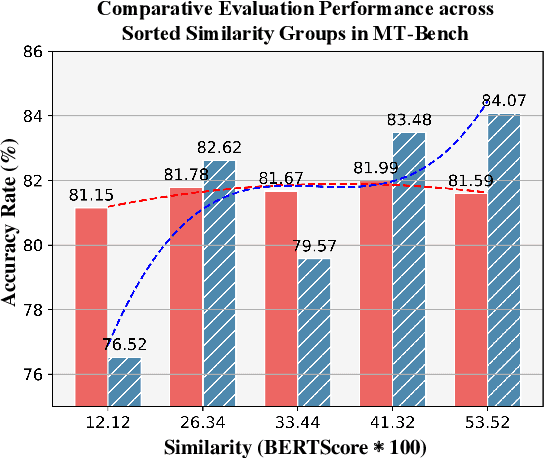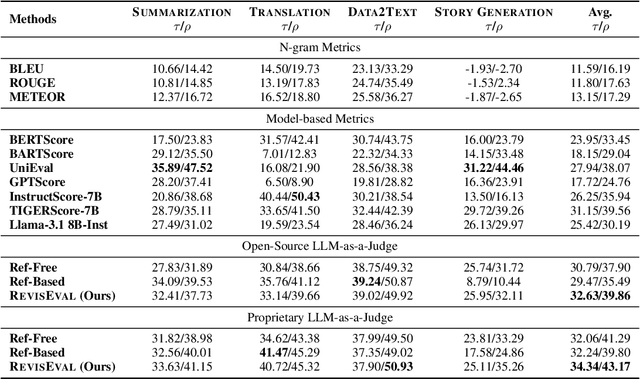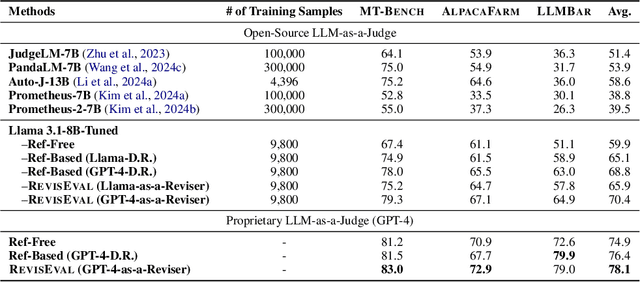Lifeng Shang
ToolACE-R: Tool Learning with Adaptive Self-Refinement
Apr 02, 2025Abstract:Tool learning, which allows Large Language Models (LLMs) to leverage external tools for solving complex user tasks, has emerged as a promising avenue for extending model capabilities. However, current approaches primarily focus on data synthesis for fine-tuning LLMs to invoke tools effectively, largely ignoring how to fully stimulate the potential of the model. In this paper, we propose ToolACE-R, a novel method that introduces adaptive self-refinement for tool invocations. Our approach features a model-aware iterative training procedure that progressively incorporates more training samples based on the model's evolving capabilities. Additionally, it allows LLMs to iteratively refine their tool calls, optimizing performance without requiring external feedback. To further enhance computational efficiency, we integrate an adaptive mechanism when scaling the inference time, enabling the model to autonomously determine when to stop the refinement process. We conduct extensive experiments across several benchmark datasets, showing that ToolACE-R achieves competitive performance compared to advanced API-based models, even without any refinement. Furthermore, its performance can be further improved efficiently through adaptive self-refinement. Our results demonstrate the effectiveness of the proposed method, which is compatible with base models of various sizes, offering a promising direction for more efficient tool learning.
DAST: Difficulty-Aware Self-Training on Large Language Models
Mar 12, 2025Abstract:Present Large Language Models (LLM) self-training methods always under-sample on challenging queries, leading to inadequate learning on difficult problems which limits LLMs' ability. Therefore, this work proposes a difficulty-aware self-training (DAST) framework that focuses on improving both the quantity and quality of self-generated responses on challenging queries during self-training. DAST is specified in three components: 1) sampling-based difficulty level estimation, 2) difficulty-aware data augmentation, and 3) the self-training algorithm using SFT and DPO respectively. Experiments on mathematical tasks demonstrate the effectiveness and generalization of DAST, highlighting the critical role of difficulty-aware strategies in advancing LLM self-training.
Learning to Align Multi-Faceted Evaluation: A Unified and Robust Framework
Feb 26, 2025Abstract:Large Language Models (LLMs) are being used more and more extensively for automated evaluation in various scenarios. Previous studies have attempted to fine-tune open-source LLMs to replicate the evaluation explanations and judgments of powerful proprietary models, such as GPT-4. However, these methods are largely limited to text-based analyses under predefined general criteria, resulting in reduced adaptability for unseen instructions and demonstrating instability in evaluating adherence to quantitative and structural constraints. To address these limitations, we propose a novel evaluation framework, ARJudge, that adaptively formulates evaluation criteria and synthesizes both text-based and code-driven analyses to evaluate LLM responses. ARJudge consists of two components: a fine-tuned Analyzer that generates multi-faceted evaluation analyses and a tuning-free Refiner that combines and refines all analyses to make the final judgment. We construct a Composite Analysis Corpus that integrates tasks for evaluation criteria generation alongside text-based and code-driven analysis generation to train the Analyzer. Our results demonstrate that ARJudge outperforms existing fine-tuned evaluators in effectiveness and robustness. Furthermore, it demonstrates the importance of multi-faceted evaluation and code-driven analyses in enhancing evaluation capabilities.
DocPuzzle: A Process-Aware Benchmark for Evaluating Realistic Long-Context Reasoning Capabilities
Feb 25, 2025Abstract:We present DocPuzzle, a rigorously constructed benchmark for evaluating long-context reasoning capabilities in large language models (LLMs). This benchmark comprises 100 expert-level QA problems requiring multi-step reasoning over long real-world documents. To ensure the task quality and complexity, we implement a human-AI collaborative annotation-validation pipeline. DocPuzzle introduces an innovative evaluation framework that mitigates guessing bias through checklist-guided process analysis, establishing new standards for assessing reasoning capacities in LLMs. Our evaluation results show that: 1)Advanced slow-thinking reasoning models like o1-preview(69.7%) and DeepSeek-R1(66.3%) significantly outperform best general instruct models like Claude 3.5 Sonnet(57.7%); 2)Distilled reasoning models like DeepSeek-R1-Distill-Qwen-32B(41.3%) falls far behind the teacher model, suggesting challenges to maintain the generalization of reasoning capabilities relying solely on distillation.
Crowd Comparative Reasoning: Unlocking Comprehensive Evaluations for LLM-as-a-Judge
Feb 18, 2025



Abstract:LLM-as-a-Judge, which generates chain-of-thought (CoT) judgments, has become a widely adopted auto-evaluation method. However, its reliability is compromised by the CoT reasoning's inability to capture comprehensive and deeper details, often leading to incomplete outcomes. Existing methods mainly rely on majority voting or criteria expansion, which is insufficient to address the limitation in CoT. We propose Crowd-based Comparative Evaluation, which introduces additional crowd responses to compare with the candidate responses, thereby exposing deeper and more comprehensive details within the candidate responses. This process effectively guides LLM-as-a-Judge to provide a more detailed CoT judgment. Extensive experiments demonstrate that our approach enhances evaluation reliability, achieving an average accuracy gain of 6.7% across five benchmarks. Moreover, our method produces higher-quality CoTs that facilitate judge distillation and exhibit superior performance in rejection sampling for supervised fine-tuning (SFT), referred to as crowd rejection sampling, thereby enabling more efficient SFT. Our analysis confirms that CoTs generated by ours are more comprehensive and of higher quality, and evaluation accuracy improves as inference scales.
Teaching LLMs According to Their Aptitude: Adaptive Reasoning for Mathematical Problem Solving
Feb 17, 2025



Abstract:Existing approaches to mathematical reasoning with large language models (LLMs) rely on Chain-of-Thought (CoT) for generalizability or Tool-Integrated Reasoning (TIR) for precise computation. While efforts have been made to combine these methods, they primarily rely on post-selection or predefined strategies, leaving an open question: whether LLMs can autonomously adapt their reasoning strategy based on their inherent capabilities. In this work, we propose TATA (Teaching LLMs According to Their Aptitude), an adaptive framework that enables LLMs to personalize their reasoning strategy spontaneously, aligning it with their intrinsic aptitude. TATA incorporates base-LLM-aware data selection during supervised fine-tuning (SFT) to tailor training data to the model's unique abilities. This approach equips LLMs to autonomously determine and apply the appropriate reasoning strategy at test time. We evaluate TATA through extensive experiments on six mathematical reasoning benchmarks, using both general-purpose and math-specialized LLMs. Empirical results demonstrate that TATA effectively combines the complementary strengths of CoT and TIR, achieving superior or comparable performance with improved inference efficiency compared to TIR alone. Further analysis underscores the critical role of aptitude-aware data selection in enabling LLMs to make effective and adaptive reasoning decisions and align reasoning strategies with model capabilities.
More Tokens, Lower Precision: Towards the Optimal Token-Precision Trade-off in KV Cache Compression
Dec 17, 2024Abstract:As large language models (LLMs) process increasing context windows, the memory usage of KV cache has become a critical bottleneck during inference. The mainstream KV compression methods, including KV pruning and KV quantization, primarily focus on either token or precision dimension and seldom explore the efficiency of their combination. In this paper, we comprehensively investigate the token-precision trade-off in KV cache compression. Experiments demonstrate that storing more tokens in the KV cache with lower precision, i.e., quantized pruning, can significantly enhance the long-context performance of LLMs. Furthermore, in-depth analysis regarding token-precision trade-off from a series of key aspects exhibit that, quantized pruning achieves substantial improvements in retrieval-related tasks and consistently performs well across varying input lengths. Moreover, quantized pruning demonstrates notable stability across different KV pruning methods, quantization strategies, and model scales. These findings provide valuable insights into the token-precision trade-off in KV cache compression. We plan to release our code in the near future.
ToolFlow: Boosting LLM Tool-Calling Through Natural and Coherent Dialogue Synthesis
Oct 24, 2024Abstract:Supervised fine-tuning (SFT) is a common method to enhance the tool calling capabilities of Large Language Models (LLMs), with the training data often being synthesized. The current data synthesis process generally involves sampling a set of tools, formulating a requirement based on these tools, and generating the call statements. However, tools sampled randomly lack relevance, making them difficult to combine and thus reducing the diversity of the data. Additionally, current work overlooks the coherence between turns of dialogues, leading to a gap between the synthesized data and real-world scenarios. To address these issues, we propose a Graph-based Sampling strategy to sample more relevant tool combinations, and a Planned-generation strategy to create plans that guide the synthesis of coherent dialogues. We integrate these two strategies and enable multiple agents to synthesize the dialogue data interactively, resulting in our tool-calling data synthesis pipeline ToolFlow. Data quality assessments demonstrate improvements in the naturalness and coherence of our synthesized dialogues. Finally, we apply SFT on LLaMA-3.1-8B using 8,000 synthetic dialogues generated with ToolFlow. Results show that the model achieves tool-calling performance comparable to or even surpassing GPT-4, while maintaining strong general capabilities.
Subtle Errors Matter: Preference Learning via Error-injected Self-editing
Oct 09, 2024



Abstract:Large Language Models (LLMs) have exhibited strong mathematical reasoning and computational prowess, tackling tasks ranging from basic arithmetic to advanced competition-level problems. However, frequently occurring subtle errors, such as miscalculations or incorrect substitutions, limit the models' full mathematical potential. Existing studies to improve mathematical ability typically involve distilling reasoning skills from stronger LLMs or applying preference learning to step-wise response pairs. Although these methods leverage samples of varying granularity to mitigate reasoning errors, they overlook the frequently occurring subtle errors. A major reason is that sampled preference pairs involve differences unrelated to the errors, which may distract the model from focusing on subtle errors. In this work, we propose a novel preference learning framework called eRror-Injected Self-Editing (RISE), which injects predefined subtle errors into partial tokens of correct solutions to construct hard pairs for error mitigation. In detail, RISE uses the model itself to edit a small number of tokens in the solution, injecting designed subtle errors. Then, pairs composed of self-edited solutions and their corresponding correct ones, along with pairs of correct and incorrect solutions obtained through sampling, are used together for subtle error-aware DPO training. Compared with other preference learning methods, RISE further refines the training objective to focus on predefined errors and their tokens, without requiring fine-grained sampling or preference annotation. Extensive experiments validate the effectiveness of RISE, with preference learning on Qwen2-7B-Instruct yielding notable improvements of 3.0% on GSM8K and 7.9% on MATH.
RevisEval: Improving LLM-as-a-Judge via Response-Adapted References
Oct 07, 2024



Abstract:With significant efforts in recent studies, LLM-as-a-Judge has become a cost-effective alternative to human evaluation for assessing the text generation quality in a wide range of tasks. However, there still remains a reliability gap between LLM-as-a-Judge and human evaluation. One important reason is the lack of guided oracles in the evaluation process. Motivated by the role of reference pervasively used in classic text evaluation, we introduce RevisEval, a novel text generation evaluation paradigm via the response-adapted references. RevisEval is driven by the key observation that an ideal reference should maintain the necessary relevance to the response to be evaluated. Specifically, RevisEval leverages the text revision capabilities of large language models (LLMs) to adaptively revise the response, then treat the revised text as the reference (response-adapted reference) for the subsequent evaluation. Extensive experiments demonstrate that RevisEval outperforms traditional reference-free and reference-based evaluation paradigms that use LLM-as-a-Judge across NLG tasks and open-ended instruction-following tasks. More importantly, our response-adapted references can further boost the classical text metrics, e.g., BLEU and BERTScore, compared to traditional references and even rival the LLM-as-a-Judge. A detailed analysis is also conducted to confirm RevisEval's effectiveness in bias reduction, the impact of inference cost, and reference relevance.
 Add to Chrome
Add to Chrome Add to Firefox
Add to Firefox Add to Edge
Add to Edge